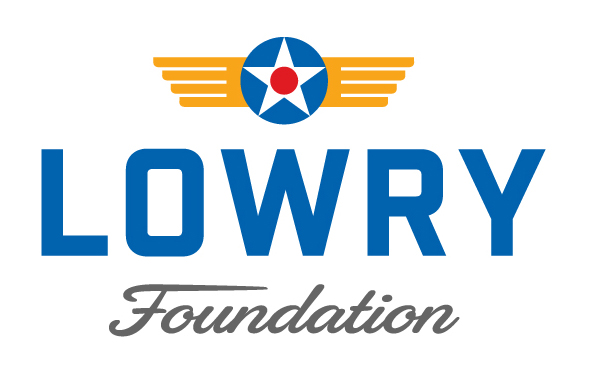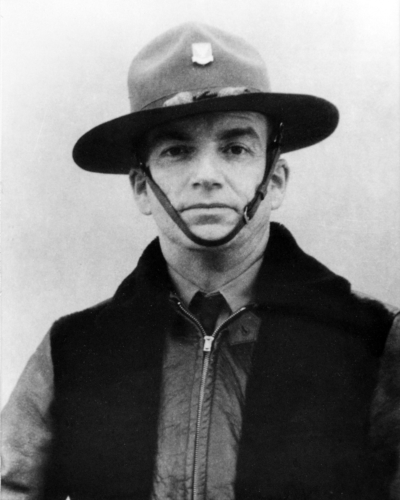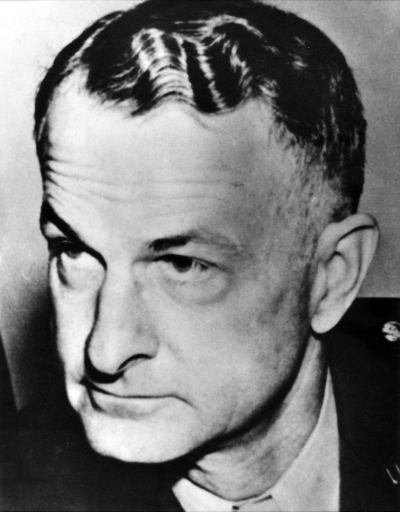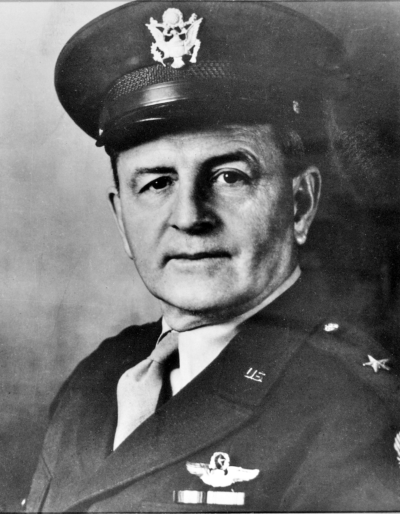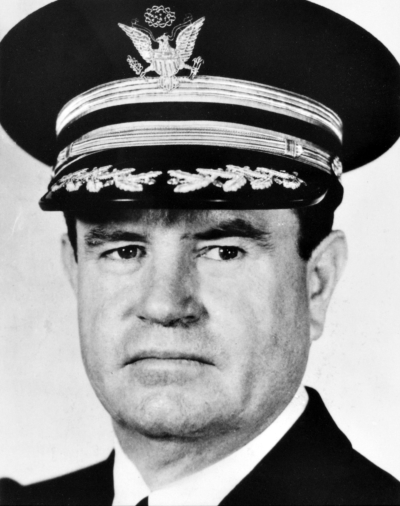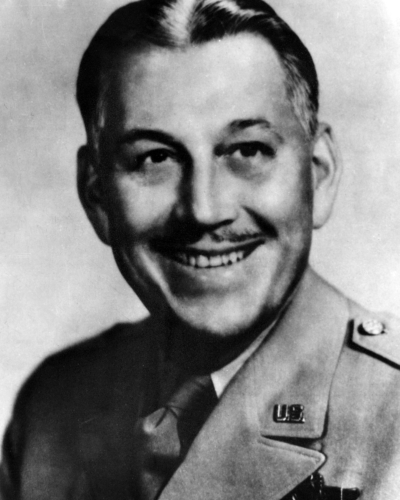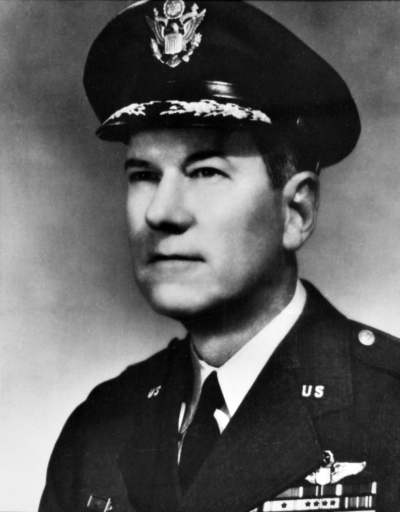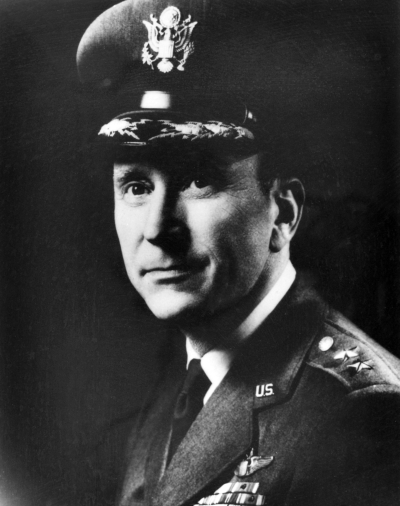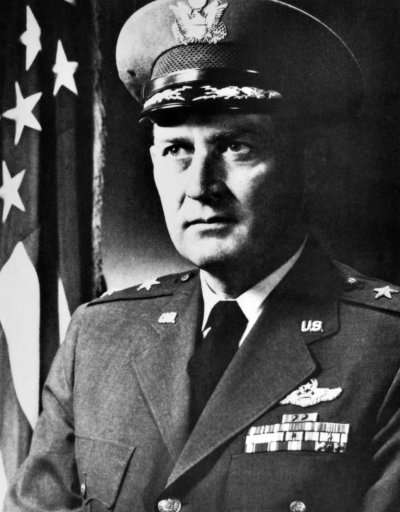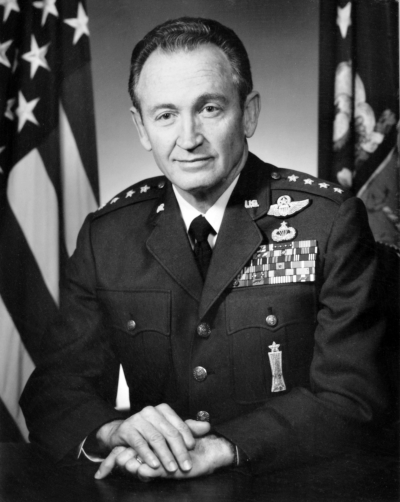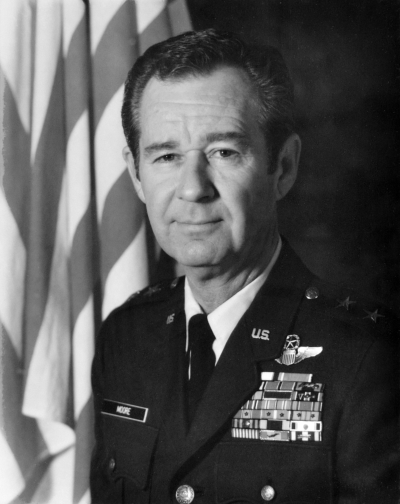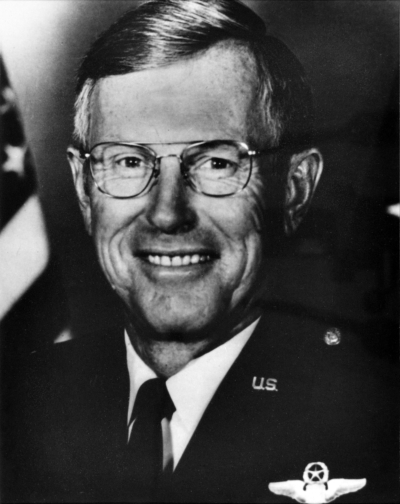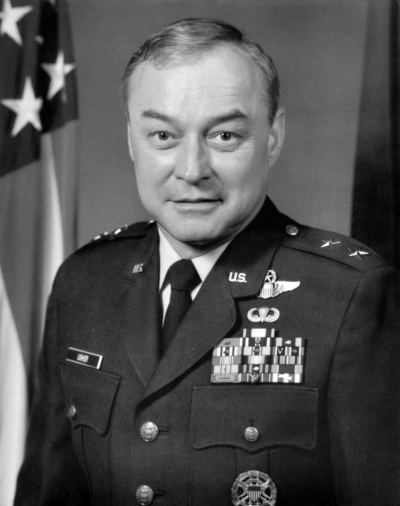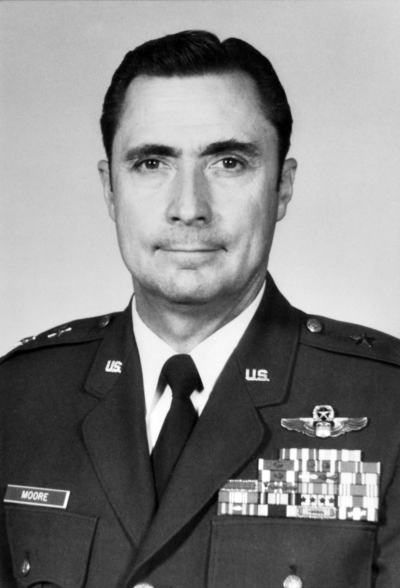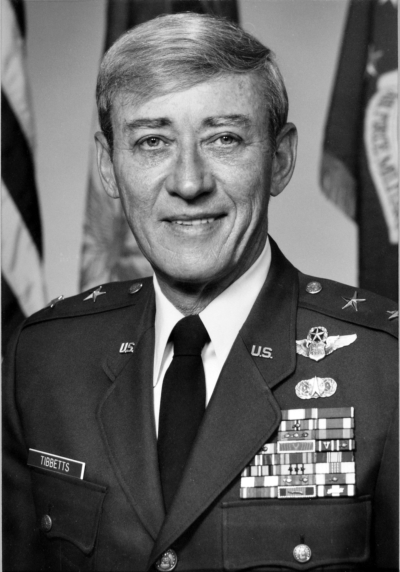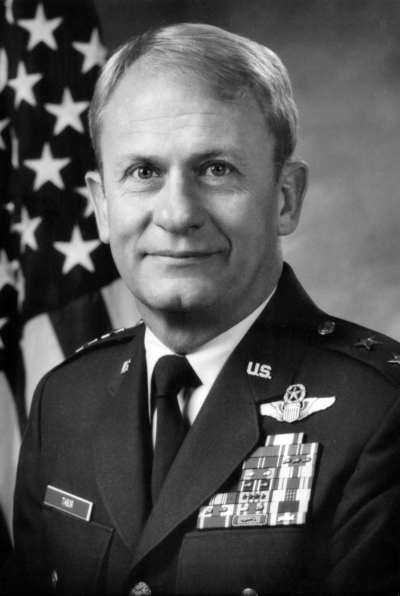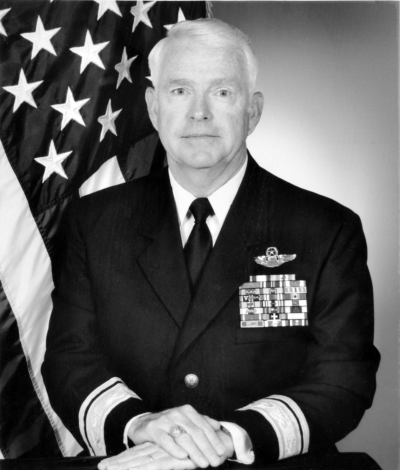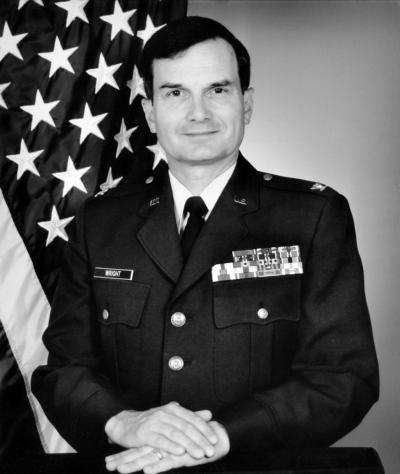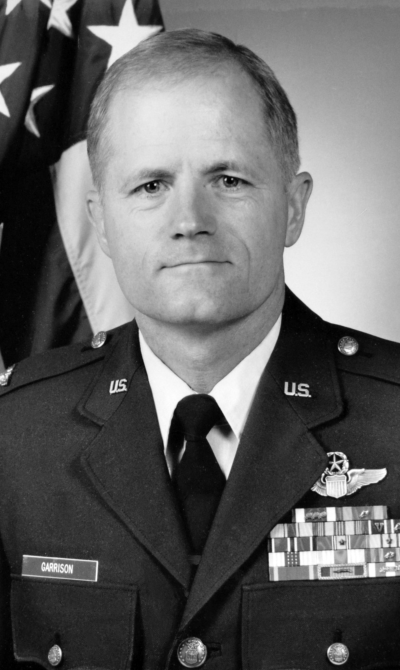Commanders
About
Lowry had 33 commanders during its 57 years of outstanding service as it grew from a small Army Air Force Field to a large U.S. Air Force Base. Lowry’s first commander was an Army Lieutenant Colonel, its last an Air Force Colonel. During the 57 years of its existence, the Base Commander’s seat was occupied by 1 Lt.Col., 6 Colonels, 7 Brigadier Generals (1Star), 17 MajorGenerals (2Stars), 1 Lieutenant General (3Stars) and 1 General (4Stars). These commanders transformed Lowry from a Tuberculosis Sanatorium and open prairie to one of the most technically oriented training facilities of its time. Training missions associated with each commander’s term of service would change as necessity dictated to reflect unfolding events around the globe, thus assuring the United States would always be in a position to defend her sovereignty and the well-being of her allies in their time of need.

Lieutenant Colonel Harold D. Stetson September 2nd, 1937- January 7th, 1938
Lieutenant Colonel Stetson, then a Captain, commanded Lowry Field when it was known as the Denver Branch, Air Corps Technical School. A quartermaster at Ft.Logan, Colorado, he was placed in charge of activating the new flying field and preparing the Agnes Phipps Memorial Sanatorium buildings for use as a school. Under his command, on 1 October 1937, the United States flag flew over the field for the first time.
Major General Junius W. Jones February 7th, 1938 – June 20th, 1938
As Commandant of the Air Corps Technical School at Chanute Field, Illinois, General Jones, then a Lieutenant Colonel, supervised the transfer of the Armament School and Photo School to Lowry. Assigned to command Lowry, he met the first cadre of students as they arrived by train on 12 February. Lowry’s first class graduated from the Armament Department on 19 March. The first aircraft—nineB-18s—landed on the new runway on 30 June 1938.
Brigadier General Jacob H. Rudolph, July 1st, 1938 – October 12th, 1940
General Rudolph commanded at Lowry Field while much of its most important early construction took place. On 19 September 1938, work began on Hanger No. 1. On 7 October 1940, Lowry formally accepted Budding 349. Known as the “Brick Barracks,” the structure housed Lowry’s permanent party personnel. Other construction included runways, NCO/Officer housing, and wood-frame student barracks. Lowry also added a third department, Clerical, to its training program.
Major General Early E. W. Duncan, October 31st, 1940- April 8th, 1942
It fell to General Duncan, then Colonel, to announce the Japanese attack at Pearl
Harbor on 7 December 1941 to Lowry personnel and to lead the base to war.
Preparation for that conflict, however, had begun much earlier. The prewar military
draft had its first impact on Lowry 13 July 1941 when more than 1,200 students
arrived — the first massive student increase in the airfield’s history. To handle the
expanded training demands, Lowry began to train under a two-shift system.
Brigadier General Harvey S. Burwell, April 9th, 1942 – April 14th, 1943
General Burwell commanded Lowry during the early part of World War II. Aircraft at the field consisted of virtually every army plane in the inventory including P-38s, P-40s, P- 51s, B-17s, and B-25s. Students at Lowry also trained on the Norden bomb sight. The first inter-service training at Lowry of any magnitude began when Marines from Cherry Point, North Carolina began receiving instruction in power-operated gun turrets.
Brigadier General Albert L. Sneed, April 15th, 1943 – August 18th, 1944
The diversity in personnel being trained at Lowry increased during General Sneed’s tenure in command. On 17 April 1943, the first class of black airmen graduated from the Photography School. On the same day, that school also graduated Lowry’s first class of females from the Women’s Army Air Corps. Political glamour touched Lowry on 24 April 1943 when President Franklin D. Roosevelt toured the field as part of an inspection tour of American military facilities.
Colonel Raymond P. Todd, August 19th, 1944 – December 8th, 1944
Colonel Todd was actually interim commander from 19 August until 14 November and then permanent Commander until 8 December. During his short tenure, Lowry’s flying mission changed with arrival of the mighty four-engined B-29s. The Superfortresses came as a part of the transfer of the Flight Engineering School from Smoky Hill Air Field at Salina, Kansas, in October 1944.
Colonel John B. Patrick, December 9th, 1944 – November 13th, 1945
Colonel Patrick commanded Lowry Field at the end of World War II and supervised the transition to a peacetime Army Air Force. Before the war ended, Lowry opened a new school specializing in B-29 crew training. On 8 May 1945 however, Lowry celebrated the surrender of Germany and the end of war in Europe — VE Day. Colonel Patrick announced the surrender of the Japanese on 14 August 1945. With the end of World War II, Lowry’s training Mission declined, the field abandoned its three-shift wartime training schedule, and its personnel resumed the slower pace of peacetime operations.
Brigadier General Thomas M. Lowe, November 14th, 1945 – June 1st, 1947
Under General Lowe, Lowry spent most of its last days as an army field. During his tenure, Lowry established Provisional Squadrons within the regularly constituted squadrons. These were designed to allow squadron commanders to exercise better supervision of personnel. The training program was severely impacted during February 1946 by an epidemic of disease that forced the schools to close for two weeks. Lowry received an important visitor on 17 February 1946 when General of the Armies Dwight D. Eisenhower toured the facility.
Brigadier General Rosenham Beam, June 2nd, 1947 – October 14th, 1948
Brigadier General Beam, then a Colonel, supervised the transition from Lowry Field to Lowry Air Force Base as the Army Air Force became the United States Air Force. President Harry S. Truman signed the National Security Act creating the Department of Defense on 26 July 1947. As a result, the USAF came into being on 18 September 1947. The effects at Lowry included creation of the 3415th Technical Training Wing on 26 August 1948 to serve as its training organization.
Major General Warren R. Carter, October 15th, 1948 – March 25th, 1950
In the tranquil days prior to the Korean War, Lowry AFB was busy continuing its training for and responding to the needs of the newly established Air Force. General Carter’s tenure in command featured visits by two important individuals. On 25 July 1949, Secretary of the Air Force Stuart Symington arrived at the base. On 6 August 1949, General Eisenhower returned to Lowry for a short visit. Mrs. Eisenhower’s family home was in Denver.
Major General Warren R. Carter, Octboer 15th, 1948 – March 25th, 1950
In the tranquil days prior to the Korean War, Lowry AFB was busy continuing its training for and responding to the needs of the newly established Air Force. General Carter’s tenure in command featured visits by two important individuals. On 25 July 1949, Secretary of the Air Force Stuart Symington arrived at the base. On 6 August 1949, General Eisenhower returned to Lowry for a short visit. Mrs. Eisenhower’s family home was in Denver.
Major General John T. Sprague, November 11th, 1950 – October 31st, 1956
During General Sprague’s tenure, Lowry’s training program saw continued change, and Lowry experienced a great deal of glamour. Older courses such as aircraft gunnery were discontinued and the teaching of new subjects like missile fundamentals entered the program. Glamour came from a President. In 1953, 1954, and 1955, Lowry received national prominence as the “Summer White House” of President Eisenhower who made his office in the old administration building. More glamour was added in 1954 when the USAF established the Air Force Academy at Lowry while its permanent buildings were built near Colorado Springs.
Major General Eugene P. Mussett, November 1st, 1956 – May 31st, 1960
While General Mussett commanded Lowry, the Air Force Academy facilities near Colorado Springs were completed. On 30 and 31 August 1958, the cadets moved to the permanent site. The 703d Strategic Missile Wing was activated at Lowry in 1958 and in June 1959 construction began on Titan missile sites on the unused Lowry Bomb Range, later known as Lowry Missile Range No. 1. At Lowry, a major organizational change occurred on 1 January 1959; the 3415th Technical Training Wing officially became Lowry Technical Training Center
Colonel Ladson K. Eskridge, June 1st, 1960 – September 5th, 1960
Colonel Eskridge served as interim commander of Lowry for three months prior to the arrival of Major General Charles H. Anderson. During this period, Lowry became involved in America’s space program when an SM-68 Reentry Vehicle Troubleshooting Trainer was installed. Accepted 29 July 1960, this equipment provided Research and Development type information.
Major General Charles H. Anderson, September 6th, 1960 – July 31st, 1967
General Anderson served as Lowry’s commander longer than any other officer. During his tenure, the Center Headquarters moved from Building 256 to Building 349 on 7 July 1961. Building 256 was once part of the Phipps Memorial Sanatorium that comprised the original buildings at Lowry. All the old Sanatorium buildings were then destroyed except the General’s home. Between 15 April and 25 June 1965, the Strategic Air Command removed its Titan missiles and closed Lowry Missile Range No. 1. Perhaps the saddest milestone of all — on 30 June 1966, Lowry’s last runway closed. A T-29 made the last take-off and Lowry’s flying mission closed forever. Also during June 1966, Lowry received a new addition when the 3320th Retraining Group transferred in from Amarillo Technical Training Center, Texas.
Major General Dwight 0. Monteith, August 2nd, 1967 – July 31st, 1971
The latter part of General Monteith’s tenure as commander was characterized by morale and service related construction for Lowry personnel. The Colorado National Bank opened a Lowry branch 2 January 1971. This building was followed by the opening of Lowry’s golf course. Permanent party personnel, students, and the growing retired community were served by a new commissary opened on 28 June 1971. On the last day of General Monteith’s command, 31 July 1971, a military tradition ended at Lowry — the USAF abolished Kitchen Police (KP) duties.Missile Range No. 1. Perhaps the saddest milestone of all — on 30 June 1966, Lowry’s last runway closed. A T-29 made the last take-off and Lowry’s flying mission closed forever. Also during June 1966, Lowry received a new addition when the 3320th Retraining Group transferred in from Amarillo Technical Training Center, Texas.
Major General John S. Samuel, August 1st, 1971 – July 31st, 1972
Reflecting the trends of the early 1970s, efforts toward enhancing morale and removing social inequalities of Lowry personnel took place under General Samuel. On 24 August 1971, Lowry established its Office of Social Actions. On 10 September, the Human Relations Council held its first meeting. Ground breaking ceremonies were held on 21 May 1972 for Lowry’s new chapel. Changes in the training program continued. On 1 July 1972, Lowry became home of the USAF Open Mess Management School and USAF Cook’s School.
General Alton D. Slay, September 1st, 1972 – September 5th, 1973
Construction for the 1970s begun under Generals Monteith and Samuel continued under General Slay. On 28 December 1972, Building 400, a new 1 000-man dormitory, was completed. Lowry also conducted a major reorganization of the 3415th Maintenance and Supply Group on 1 March 19 73, activating three new squadrons: Transportation, Supply, and Maintenance. On 1 January 1973, fourteen new USAF career specialties opened to Air Force women. Women in the Air Force were thus accepted in all but a few jobs involving combat flying.
Lieutenant General Charles C. Pattillo, September 6th, 1973 – August 7th, 1975
Under General Pattillo, Lowry completed a new 187-space mobile home park on 9 June 1974. The base training mission changed slightly on 16 October 1973 when the last Explosive Ordnance Disposal class graduated; responsibility for this training was assumed by the U. S. Navy. Much of General Pattillo’s efforts were centered around changes in the 3320th Retraining Group. On 1 July 1974, the 3320th implemented a retraining test program for women. The Group also moved into a brand new, five-building complex during the week of 21 April 1974.
Major General Warren C. Moore, August 8th, 1975 – December 29th, 1976
Under General Moore, on 30 April 1976 several training Departments —Audiovisual, Aerospace Munitions Training, Intelligence Training, and Logistics became, respectively, the 3430th, 3460th, 3450th and 3440th Technical Training Groups. Lowry and Public Service Company of Colorado also began a program to increase the base’s electrical capacity in anticipation of future training needs. On 30 September 1976, the new Air Force Accounting and Finance Center located on the southwest comer of Lowry was dedicated.
Major General Andrew Pringle, Jr., December 20th, 1976 – April 24th, 1978
The major event of General Pringle’s tenure in command was the reorganization of the Technical Training Center implemented on 1 January 1978. The reorganization was designed to reduce structural layering, lower the decision making level, and streamline the staff. The reorganization eliminated 91 military and civilian positions.
Major General William W. Hoover, April 25th, 1978 – September 7th, 1979
While General Hoover commanded Lowry, the process of streamlining the training organization continued. The 3420th and 3430th Technical Training Groups merged on 1 June 1978 to become the 3420th Technical Training Group. Also, on 1 June, Lowry’s USAF Technical School received accreditation for a 10-year period. The North Central Association (NCA) of Colleges and Schools provided the accreditation, thus allowing students to receive college credit for courses taken at Lowry.
Major General William B. Maxson, September 8th, 1979 – May 13th, 1981
During General Maxson’s tenure, one element of the 1978 reorganization was undone; the 3400th Technical Training Wing replaced the Deputy Commander for training, thus enhancing the importance of the training mission. During 1980 Lowry received two B-52s and an F-16 to provide realistic, hands-on training for students. On 1 March 1980, Lowry implemented the Pipeline Management System, a computer-based method of controlling the flow of students through the training pipeline.
Major General Titus C. Hall, May 14th, 1981 – April 28th, 1982
General Hall commanded Lowry Technical Training Center (LTTC) during a period that saw a rapid increase in student population. To support this increase required major emphasis on upgrading the aircraft training fleet and Lowry facilities. General Hall’s personal involvement helped LTTC secure a modern A-10 Thunderbolt II, F-16 Fighting Falcon, and an F-4E Phantom in support of technical training. The Center opened the new Avionics Training Building, and re-roofed Hangers #1 and #2. General Hall directed creation of a new INTRO Building to provide a single point of contact for all personnel entering Lowry. In support of recreational activities, Lowry’s initial construction opened a new solar pavilion for picnics and a modern bowling alley. General Hall’s personal interest led to Chapel #1 becoming a Denver Historical Landmark, and the Department of the Interior listed it on the National Register of Historic Places.
Major General William R. Usher, June 1st, 1982 – August 14th, 1985
Major General William R. Usher served as the LTTC Commander from 1 June 1982 until 14 August 1985. He stressed excellence in training and the need for wartime readiness. Equally important to General Usher was instilling the proper military attitude in the Center’s young students and providing them with a positive environment at Lowry. Lowry became the major training facility for space operations and planned courses for new Air Force weapons systems, for example, the B-1B bomber and the Peacekeeper ICBM. LTTC received MCI ratings of “Excellent” in 1983 and again in 1984. Other initiatives by General Usher included modernizing Intelligence Training, promoting quality of life at Lowry, and reducing energy consumption.
Major General Joseph D. Moore, August 15th, 1985 – October 16th 1986
Major General Joseph D. Moore directed Lowry Technical Training Center from 15 August 1985 through 16 October 1986. Under his leadership, the Center implemented Undergraduate Space Training, prepared for the transfer of Intelligence Training to Goodfellow AFB, accepted a new Peacekeeper training facility, and introduced new and enhanced courses for the B-1B, F-lll, and Peacekeeper. General Moore’s quality of life initiatives included establishing new base security procedures, renovating base housing and living quarters, upgrading base dining facilities, promoting in-state college tuition benefits for Lowry personnel, increasing safety awareness, and developing the Dillon Recreation Area.
Major General Larry N. Tibbetts, October 17th, 1986 – May 27th, 1988
Major General Larry N. Tibbetts served as Commander of Lowry Technical Training Center from 17 October 1986 to 27 May 1988. During his tenure he stressed preparation of combat-ready, technically-qualified people for the armed forces; organized a military Tattoo, drill team, and drum and bugle corps; celebrated Lowry’s 50th Anniversary; refurbished the Eisenhower Chapel and D.V. quarters; and dedicated a Student Ministry Center. General Tibbetts’ leadership contributed greatly to LTTC’s noteworthy MCI and UEI performance in 1987. He was instrumental in development of the Undergraduate Space Training program and presided at the first class’ graduation. With Lowry’s removal from the DOD base closure list, General Tibbetts worked with HQ ATC and Colorado Congressmen to restore almost $22 million in construction projects for FY88 and 89.
Major General Dale C. Tabor, May 27th, 1988 – March 4th, 1991
Major General Dale C. Tabor served as Center Commander from 27 May 1988 to 4 March 1991. Under his leadership, LTTC continued its record of excellence in technical training. High ratings on the September 1998 UEI demonstrated the quality of instruction at Lowry. He promoted the mission of the 3320th Correction and Rehabilitation Squadron throughout the Air Force, and worked to establish a centralized Air Force prison at Lowry. General Tabor’s anti-DUI campaign helped to reduce drinking and driving by base personnel. Her prepared LTTC for an expanded mission and an increased student population from the closure of Chanute AFB. As part of General Tabor’s community relations policy, base personnel hosted the Colorado Veterans Memorial benefit featuring Bob Hope, and participated in the joint Lowry-Buckly air show.
Major General Fred R. Nelson, March 4th, 1991 – July 31st, 1992
Major General Fred R. Nelson served as the Center Commander from 4 March 1991 to 31 July 1992. Under his leadership, Center personnel demonstrated excellence in technical training, including earning top honors in Air Training Command s first TOP TECH competition, improving training efficiency with Project TRAINING RELOOK,” and surpassing command goals for instructor academic achievement. General Nelson reorganized the Center to meet Air Force wing structure objectives for enhancing efficiency and effectiveness of operations. His Quality Air Force initiatives improved training support and the quality of life for Lowry personnel. In beginning the transition for the Lowry Air Force Base closure in 1994, General Nelson worked with local community officials to plan for the reuse of land and facilities.
Major General Jay D. Blume, Jr., August 1st, 1992 – April 27th, 1994
Under the command of Major General Blume, Lowry underwent major changes which included gearing the base up for closure and transferring technical training squadrons missions’ to various gaining bases. He also formed a partnership with local communities to promote viable plans for base reuse. He instituted a civilian reemployment plan which successfully placed nearly 100 percent of the Lowry civilian work force with new positions. His commitment to Quality Air Force nurtured an environment of trust, teamwork and empowerment throughout Lowry for people to manage Air Force resources.
Colonel Michael J. Wright, April 28th, 1994 – September 30th, 1994
Colonel Wright completed the closure of Lowry AFB. Under his guidance, 428 buildings were closed while 4000 tons of resources were packaged and shipped to other bases. He managed the smooth transfer of property and equipment to the local community and worked closely with the Base Closure Agency and the Lowry Redevelopment Authority to promote the sound reuse of Lowry resources. Colonel Wright focused his concern on the employees of Lowry and facilitated their transition to other employment. He orchestrated an inactivation and closure ceremony that will remain a lasting tribute to legacy of Lowry Air Force Base and the support of the surrounding communities.
Colonel George F. Garrison, August 3rd, 1992 – September 30th, 1994
Support Group Commander for Closure.
